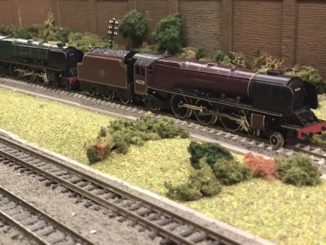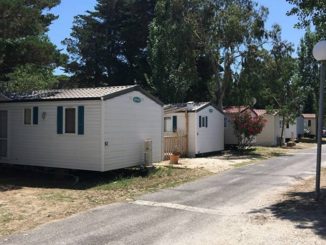
© Google Maps 2022, Google
As we continue the Nostalgia Album 1952 return trip to England, after leaving north eastern Spain and Catalonia, it is time to traverse the Pyrenees. The next sequence of photos helps to recreate the route. Thankfully the images were well captioned seven decades ago. As you can see from the numbered positions on the map above, it was not a straightforward direct crossing of the 270-mile long and 80-mile wide mountain range that separates Spain and France. Can you guess why?
En route, we encounter a series of mountain passes. The French word for such is ‘col’, literally suggesting a ‘collar’, as if a narrow, pinched, part of a mountain range. My father and grandparents drove from right to left from 1 to 4.
Col de Portet d’Aspet (1)

© Always Worth Saying 2022, Going Postal
The Col de Portet d’Aspet rises to an elevation of elevation 3,507 ft. This is in the central Pyrenees in the department of Haute-Garonne and passes the Pic de Paloumère, a mountain that rises to 5,276 ft. This pass appears regularly in the Tour de France and was most recently used as a stage in 2021, albeit in the opposite direction to our trip.
Col de Peyresourde (2)
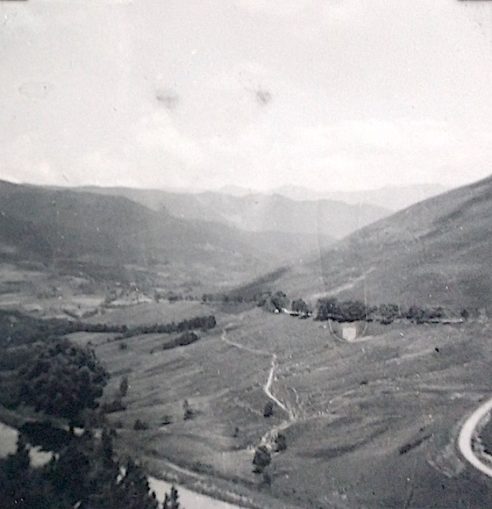
© Always Worth Saying 2022, Going Postal
The Col de Peyresourde rises to an impressive 5,148 ft and sits on the border of the French departments of Haute-Garonne and Hautes-Pyrénées. It is situated on the D618 road on the way to Arreau. Beyond the summit, the route heads due west while dropping to Loudervielle after which it heads north to Arreau.

© Always Worth Saying 2022, Going Postal
On the way up, the valiant Ford 8 has disgraced herself, requiring my grandfather, fortunately a motor mechanic, to operate. After unfolding the right-hand side of the bonnet something wet appears to have been extracted, dismantled and cleaned or a replacement improvised. Before the front off-side wheel there seem to be more parts laid out. A good sign when an expert is in charge!
Noticeable in my grandfather’s right ear is his hearing aid. Elihu was profoundly deaf which didn’t stop him from volunteering and serving during the war. There’s a suggestion he might have been deafened by the agricultural machinery he worked on as a fitter. In the Worth-Saying tradition, my grandfather was a gentleman far from uncomfortable with his own company. My father used to say of him that when my grandmother’s lady friends called, he could be spotted surreptitiously switching off his hearing aid and spending the evening sitting in a corner of the front room randomly nodding and smiling. Wise man.

© Always Worth Saying 2022, Going Postal
The sign at the summit of Col de Peyresourde is still there and remains as pictured. At the top, in red on white, it reads, “RN (Route National?) 618 de St-Jean-de-Luz a Argeles-sur-mer. 17K’s Arreau (an arrow points left) 14K’s Bagneres de Luchon [an arrow points right]. Col de Peyresourde altitude 1.563m (5,127 ft or 5,069 ft according to our album)”.
Also in the photo, you’ll note the Union Jack is being flown on the front of the car as is what looks like a Spanish flag. Quite a way from the border, this will (rightly) be to antagonise the French. The registration is ERM 38, RM being the old area code for Cumberland. Look at the badges there’s what looks like an AA badge at the top. Extra house points to any Puffin who makes a sensible guess in an unread comment regarding the other two.
I can recall the RRM 1 number plate being used on Rolls Royces, with the initials standing for Rolls-Royce Motors. The RRM1 registration was sold by Bonhams for £67,000 at the Goodwood Revival in 2018. At the same sale, the previous lot was RR1 which went for a cool £460,000. The next lot was a whole car, a 1953 Jaguar XK120 3.8-Litre Competition Roadster, which changed hands for a mere £48,300. It was reported in the press that the owners of the registrations were thought to be Bentley motor vehicles. The last time RR1 had changed hands was in the late 1960s when it sold for a then-world record price of just under £5,000.
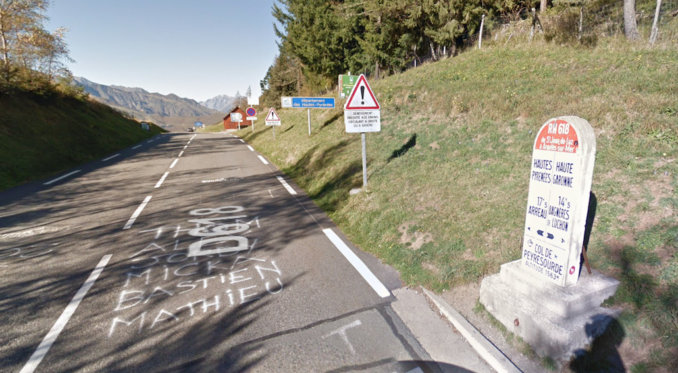
© Google Street View 2022, Google
In the modern day, the summit sign has company. The French have gone mad with road signs thereabouts and have also been writing on the road, presumably because the Tour de France goes that way. Amongst other things, the modern signs read “Beware of avalanches for 1600 m” and “Snow removal. Priority for vehicles travelling on the right or on the left”. I think you can also make out the back of a cycling information sign. These are placed at regular intervals on popular mountain routes to inform cyclists of gradients and distances.
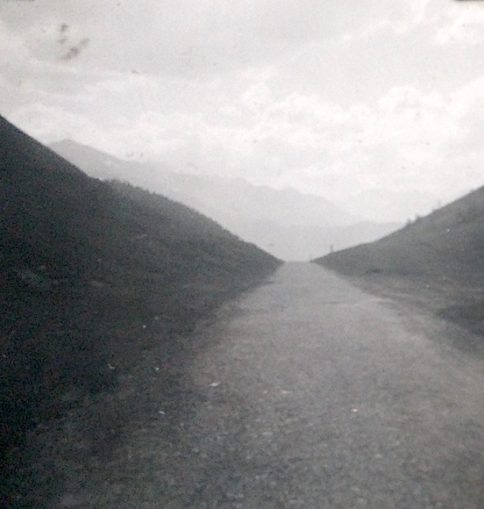
© Always Worth Saying 2022, Going Postal
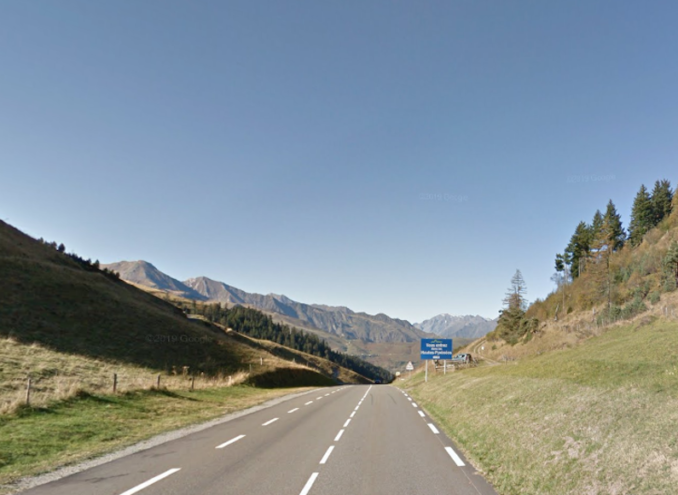
© Google Street View 2022, Google
Although it doesn’t look it, the above two photographs are taken at the same place. Looking at the old image captioned ‘Going down’, you can see the same forestry on the left and mountain peak above the trees as can be seen in the street view image. I hope it’s a bad photo and in real life our travellers got to enjoy the magnificent Pyrenean mountain views as they drove down to Loudervielle then north to Arreau from where the next pass, the Col d’Aspin, begins.
Col d’Aspin?
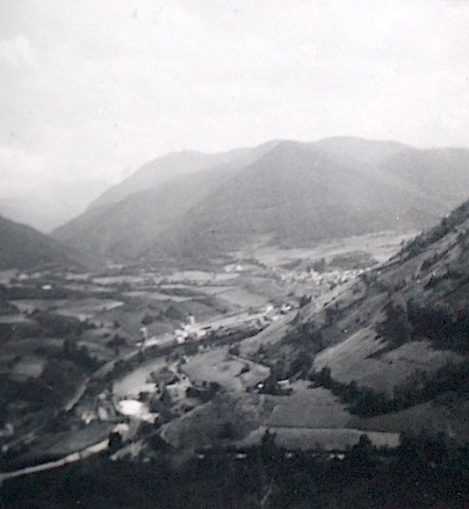
© Always Worth Saying 2022, Going Postal
Although the next photograph is captioned Col d’Aspin, it is at the start of the climb to that summit on a route called Ruisseau d’Aspin and is looking back towards Arreau. How can I be so certain? Because a railway line can be spotted curving around the far bank of the river. Reference to the map shows that in Arreau, although there is no longer a railway, there is a Chemin de Frechet following the route of the railway line in the old photograph. There is also an Avenue de la Gare and Place de la Gare closer to the town centre.
Via Street View, Place de la Gare is a road but its alignments and a cutting suggest it’s built on top of an old track bed. Sure enough, there is even a building called ‘The Terminus’. However, this looks nothing like the old station building and turns out to be a banqueting hall.

Carte postale des années 1900,
Labouche frères Toulouse – Public domain

© Google Street View 2022, Google
Only yards further along the road, we do come to the real old Gare d’ Arreau. Note the distinctive windows on the gable end. The new building attached to the gable end is signed as the Maison de la Chasse which means ‘hunting house’ and is the headquarters of the very grand sounding ‘SOCIETE INTERCOMMUNALE DE CHASSE D’ARREAU’. The society’s mission statement reads, ‘Fight against poaching, destruction of pests, respect for harvests.’ In other words, the continental wild fowling tradition of shooting at everything that moves.
The other buildings around about seem to be to do with forestry. There is a furniture shop, a buildings material supplier and a carpenters. In the old photo, just beyond the bend in the river, you can see some industrial-style buildings, perhaps a sawmill or some such? As the eye drifts further to the right, you can spot the old railway station when still a white building standing alone.
As for the line itself, I’m indebted to M. Bernard Collardey who informs me that the Arreau to Lannemezan line was opened on 1st August 1897 by the Compagnie du Midi. A single line covered the 25 km and at Lannemezan connected with the Toulouse to Bayonne mainline. At first, I was grateful to M. Collardey for his article Ligne Lannemezan – Arreau dans la Vie du Rail dans les années 1980 but, as you will see, I grew to hate him.
Bayonne is on the Atlantic coast and runs into Biarritz which was where my father and grandparents stayed on the outward journey. In the other direction, at Toulouse, you can connect with services to Narbonne which takes you to the opposite, Mediterranean, coast. The original plan was for the Compagnie du Midi to continue the route via Arreau into Spain but the cost of tunnelling and climbing steep gradients proved prohibitive. Journeys to the popular winter sports resort of St Lary and the Neouvielle lake reserve were continued by road. A twisting alignment, the ruling grade was 15 %o. A very French way of expressing it, this means 15 in a thousand rather than the superior Anglo Saxon method of using hundreds. Better still, express such things as a gradient. What Bernard really meant was that the ruling grade was 1/66.
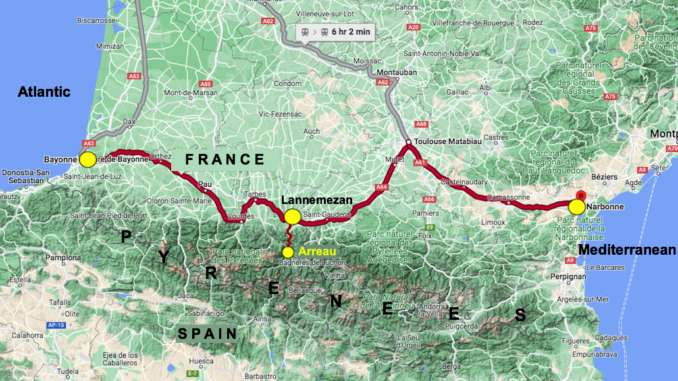
© Google Maps 2022, Google
The reason for this is Frenchness is probably because distances are expressed as kilometres down to a thousandth rather than the easier Imperial method of miles and chains. Therefore, according to Bernard, one of the line’s private sidings sitting south of Sarrancolin is located at PK139,781 (presumably meaning 139.781 km from Toulouse). What’s wrong with 88 miles and 68 chains? Or, just after Mile Post 88 and three quarters? It is so much easier to remember. The French are stupid.
He also did all the elevations in metres and uses full stops instead of commas. I shall convert. Lannemezan sits at an altitude of 2,011ft. The summit of the route is at Labarteavezac at an elevation of 2,129 ft after which the line drops to 1,991 ft at Heches before rising to 2,306 ft at Arreau (also known as Arreau-Cadeac). The river beside the tracks is the Neste d’Aure. Having looked at the old photo, we can agree with M. Bernard that the environs are a moderately mountainous landscape made of wood and meadows.
As a single line, the track had no signalling and was electrified in 1917 to a very French 12KV 16 2/3Hz AC. At this point, steam traction was made redundant. In 1923, the line was energised to the national standard of 1500V, fed from the Eget power station on the Neste de Complan in the Neouville Massif, which we shall assume to be a hydroelectric scheme. Passenger services were provided by Midi Z 23002 railcars. Z 23200 self-propelled goods vans towing other wagons provided a freight service.
After the war, there were three or four return passenger services a day and with goods traffic being hauled by BB 4200 Class electric locomotives. In the 1960s, car competition impacted passenger numbers. FNC railcars were introduced but in the spring of 1969 passenger services ended and were replaced by the present-day coach service which takes 35 minutes to cover the route. Busses are timed to connect at Lannemezan with express rail services to and from Toulouse. For winter skiing, some coach services are extended from Arreau to Saint-Lary.
In the 1980s freight traffic along the line still thrived with almost 400,000 tons of goods being moved annually, albeit only on the northernmost part of the line. The Ugine Kuhlmann factory received supplies of coke and sulphuric acid and despatched fertiliser. The Aluminium-Pechiney factory took deliveries of alumina, coke and other chemical and despatched finished aluminium.
This excellent video, in French with English subtitles, shows the present state of the line with freight activity continuing close to Lannemezan. Some of the catenary remains in place further along the route with the road not replacing the permanent way until closer to Arreau.
Next time we shall traverse passes three and four, with the promise of a remarkable surprise at the top of one of them. In the meantime, why this meandering route through the Pyrenees? Where were they going and why?
Find out next time on Nostalgia Album!
© Always Worth Saying 2022

